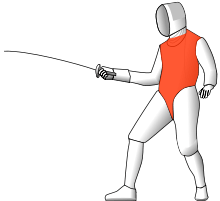Foil (fencing)

A foil is one of the three weapons used in the sport of fencing, all of which are metal. It is flexible, rectangular in cross section, and weighs under a pound. As with the épée, points are only scored by contact with the tip, which in electrically scored tournaments is capped with a spring-loaded button to signal a touch. A foil fencer's uniform features the lamé, a vest, electrically wired to record hits in such cases. It is the most commonly used weapon in competition.
Electric and nonelectric foils

The components common to both varieties are the pommel, grip, guard, thumb pad, and blade.
There is the nonelectric foil, known as "steam" or "dry", and the electric. Both varieties are capped with a plastic or rubber piece, with a button at the tip in electric blades. A judge is required to determine the victor in a tournaments with nonelectric foils.
The Fédération Internationale d'Escrime[1] and most national organisations require electric scoring apparatus, although some organizations still fence competitively with nonelectric swords. Nonelectric ones are primarily used for practice.
There are also a range of plastic swords made by varying manufacturers for use by juniors.
Blade
Foil have standardized, tapered, quadrangular (rectangular) blades that are made of tempered and annealed, low-carbon steel and are designed to bend upon striking an opponent in order to prevent both injuries and breakage of the blade. For international competition maraging steel is required. The foil blade is no more than 90 cm in length with a blunted (or foiled) tip. The maximum length of the assembled weapon is 110 cm; the maximum weight is 500g, but most competition swords are lighter, closer to 350g.
The blade itself is subdivided into 3 regions: the foible, or "weak", the last third of the blade near the tip; the medium; and the forte, or "strong", the third of the blade near the guard. Inside of the grip is the tang which is threaded at the end to allow the pommel to fasten the foil assembly together. When an Italian grip is used a ricasso extends from under the guard, inside of the grip's quillons, into the tang.
Guard assembly

The pommel, a type of threaded fastener used to fasten blade, guard, plug, and grip assemblies together, is specific to the type of grip that is used. There are two types of grips used for foils: straight grips with long, external pommels, comprising the French, Italian, and Spanish varieties, and orthopedic, or pistol grips, which are designed to fix the hand in a specific position and have pommels that fit into a countersink in the back of the grip. Foil guards are limited to a diameter of 9.5 to 12 cm in international competition.
Electric foils

Starting with the 1956 Olympics, scoring in foil is accomplished by means of registering the touch with an electric circuit. A switch at the tip of the foil registers the touch, and a metallic foil vest, or lamé, verifies that the touch is on valid target.[3]
Socket
The electric foil contains a socket underneath the guard that connects to the scoring apparatus via the body cord and a wire that runs down a channel cut into the top of the blade. Electric foil sockets are fixed so that the body cord plugs into the weapon at the fencer's wrist. There are two main varieties in use today: the two-prong variety which has unequal diameter prongs and is held in place by a retaining clip, and the single-prong "bayonette" which twist-locks into place.
Tip
The tip of the electric foil terminates in a button assembly that generally consists of a barrel, plunger, spring, and retaining screws. The circuit is a "normally closed" one, meaning that at rest there is always a complete power circuit. Depressing the tip breaks this circuit, and the scoring apparatus illuminates an appropriate light: white or yellow for hits not on the valid target area (depending on the design of the lights on the scoring machine), or either red or green representing hits on the valid target area (red for one fencer, green for the other).
History

The modern foil is descended from the training weapon for the small-sword, the common sidearm of 18th century gentleman. Rapier and even longsword foils are also known to have been used, but their weight and use were very different.
Although the foil as a blunted weapon for sword practice goes back to the 16th century (for example, in Hamlet, Shakespeare writes " let the foils be brought"[4]), the use as a weapon for sport is more recent. The foil was used in France as a training weapon in the middle of the 18th century in order to practise fast and elegant thrust fencing. Fencers blunted the point by wrapping a foil around the blade or fastening a knob on the point ("blossom", French fleuret). In addition to practising, some fencers took away the protection and used the sharp foil for duels. German students took up that practice in academic fencing and developed the Pariser ("Parisian") thrusting small sword for the Stoßmensur ("thrusting mensur").
The target area for modern foil is said to come from a time when fencing was practised with limited safety equipment. Another factor in the target area is that foil rules are derived from a period when dueling to the death was the norm. Hence, the favoured target area is the torso, where the vital organs are.
In 1896, foil (and saber) were included as events in the first Olympic Games in Athens.[5]
Women's Foil
Women's foil was first competed at the Olympics in 1924 in Paris,[5] and was the only Olympic fencing event in which women competed until women's epeé was introduced at the 1996 Olympics.[6]
Rules
The rules for the sport of fencing are regulated by the national sporting association. In the United States, this is the United States Fencing Association (USFA).[7] International rules are regulated by the International Fencing Federation, or Fédération Internationale d'Escrime (FIE).[1]
The detailed rules for foil are listed in the USFA Rulebook.[8]
Rules for the sport of fencing date back to the 19th century.[9] The current international rules for foil were adopted by the FIE Committee for Foil on 12 June 1914. They are based on previous sets of rules adopted by national associations. The rules governing the use of electrical judging apparatus were adopted in 1957 and have been amended several times.[10]
Scoring
The foil is used as a thrusting (or point) weapon only. Contact with the side of the blade (a slap or slash) does not result in a score. The tip of the foil must be depressed for 15 (± 1) milliseconds while in contact with the opponent's lamé (wire-mesh jacket which covers valid target area) to score a touch. The tip must be able to support a minimum force of 4.90 newtons (500 grams-force) without the circuit breaking. This is tested with a 500g (± 3g) weight.[8]
Target area
In foil the valid target area includes the torso (including the lower part of the bib of the mask) and the groin. The head (except the lower part of the bib of the mask), arms, and legs are considered off target. Touches made off target do not count for points, but do stop play.[3]

Priority (or right of way)
Foil is governed by the rules of priority, also known as right of way.[3] As such, points are not necessarily awarded to the first fencer to hit, but to the fencer who hits with the priority. As such foil fencing consists of not just trying to hit the opponent, but also 'battling for priority', which adds a tactical dimension to the game. Priority is established when one fencer starts a correctly executed attack. An attack which has failed (i.e. has missed, stopped forward progress or been parried) no longer holds the priority. The convention of refereeing will automatically give right of way to the defender provided they take over immediately with their 'answering' action. Priority automatically passes to the defending fencer when they parry; Where the attack was parried, the defender has the right to make a riposte, but it must be initiated without indecision or delay; In other words, if the defending fencer parries successfully, but then waits and does not immediately riposte, they lose the right of way. The fencer making the original attack may also make a new offensive action, a renewal or remise of the initial attack but there is certain risk in doing so, for example when they have been parried, because they would then be making renewal/ remise while their opponent had the priority. There are a special range of fencing actions in this situation; A classical response where the defender parries the attack successfully and begins riposting is for the attacker to recover from their lunge and make a counter parry (a parry of the defenders riposting action) and riposte in turn. This is called the counter riposte.
In foil only actions that arrive with priority are considered valid for scoring a point (unless only one fencer actually hits, in which case having the priority is immaterial, and the fencer whose action arrived would be awarded the point provided that it was on the target area). In the case of both fencers actions arriving where the fencer with priority hit off target then even if the other fencer hits on target, no point is to be awarded, as priority takes precedence. However play is halted and the fencers reset to en guard. In the case where both of the fencers hit on target, the fencer who had priority is awarded the point. There can be a situation when both fencers attack where the referee cannot decide who began; "simultaneous action", in which no point is awarded.
See also
References
- 1 2 FIE website (accessed 19 January 2016).
- ↑ "Is My Grip Legal?", US Fencing Officials Commission website (accessed 26 Feb 2016)
- 1 2 3 About Fencing Weapons (accessed 19 Jan 2015)
- ↑ William Shakespeare, Hamlet, Act V, Scene II (accessed 20 February 2016).
- 1 2 FIE History: Fencing history (accessed 21 Jan 2016)
- ↑ Reference: Olympic website, Fencing Equipment and History (accessed 22 January 2016).
- ↑ United States Fencing Association website (accessed 19 January 2016).
- 1 2 USA Fencing Rulebook (accessed 19 January 2016).
- ↑ rules used by the Amateur Fencers’ League of America dating to 1891 can be found at the Museum of American Fencing site, Rule Books (accessed 21 Jan 2016)
- ↑ "Historical note," THE FIE RULES FOR COMPETITIONS, THE BRITISH FENCING ASSOCIATION, Updated January 2014 (accessed 21 Jan 2016)
External links
- Official website – International Fencing Federation
